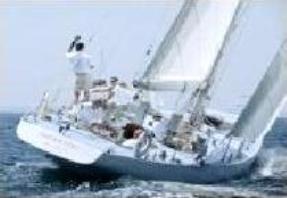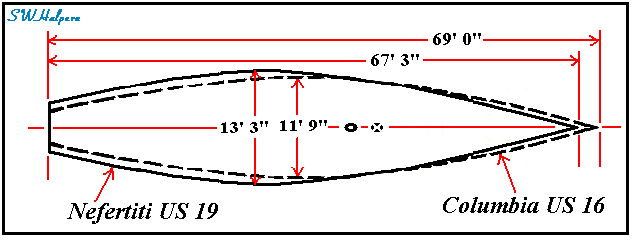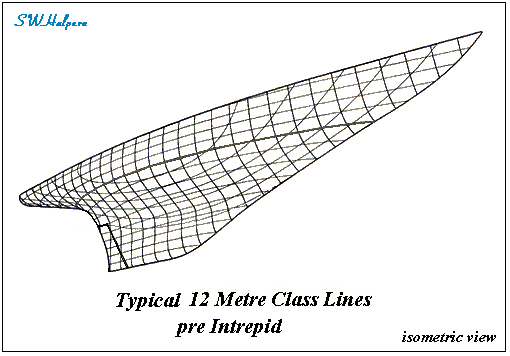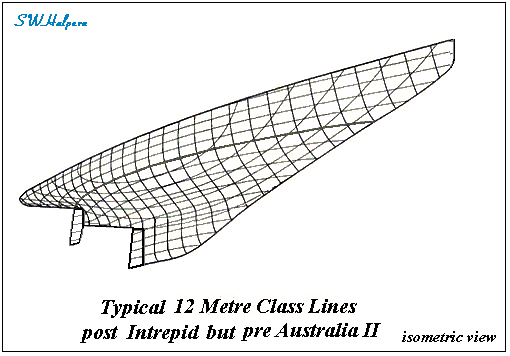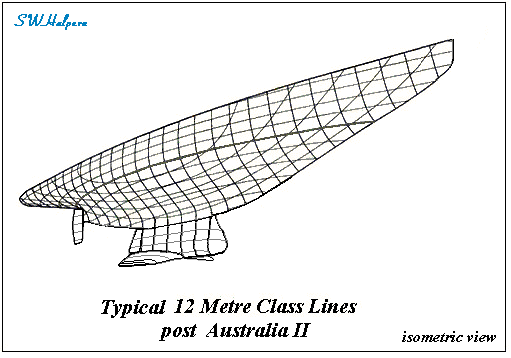| America's Cup Racing Yachts Evolution of a Design - The 12 Metre Class |
| Following the era of the J boats came the 12 metre class from 1958 to 1988. It was during the 1962 defense of the cup that I got interested in yacht design as a hobby after reading about Ted Hood's approach to designing the new defender candidate Nefertiti (US 19) which went up against the older 12 metre boats: Columbia (US 16), designed by Olin Stephens, Weatherly (US 17), designed by Philip Rhodes and modified in 1962 by A.E. "Bill" Luders, and Easterner (US 18), designed by C. Raymond Hunt. Nefertiti came very close to defending the America's Cup in 1962. Ted Hood took a different approach to the 12 Metre Rule producing a yacht with greater beam and less displacement (which happened to give her the largest interior volume of any of the Twelves). The idea was to build a yacht that was a platform to optimise the sail plan. Non of the other yachts could catch Nefertiti on a reach. "Neffy" ousted both Easterner and Columbia in the 1962 Defender's preliminary trials. In the Defender Finals, however, the older 1958 boat Weatherly proved to be the boat to beat in the lighter breezes of August. Weatherly went on to win the America's Cup that year against the Australian 12 metre Gretel. |
| The Twelve Metre Class Rule was revised before the America's Cup Jubilee in Cowes, UK in 2001 so that yachts spanning nearly a century could race among similar vintages. There were three divisions: - The Classic Division for 12s having keel-hung rudders pre-dating the 1967 Intrepid breakthrough design. - The Modern Division for 12s from Intrepid to Australia II having separated rudder aft with a trim tab on a reduced-size keel. - The Grand Prix Division for the winged-keel America's Cup fleet of 1987 plus Australia II, the 1983 breakthrough design. |
| From 1958 to 1987, the "12-Meter" Rule was used to ensure that similar designs competed for the America's Cup, while still encouraging yacht designers to balance several key design factors in order to produce the fastest boats possible. The rating formula was: R = (L + 2d + sqrt[S] - F)/2.37 = 12 meters Where: L = The length measured at a height of 1.5% of the class rating (12 meters) above the flotation line, adjusted for the girth measurements forward and aft. d = The difference between the skin girth and the chain girth, measured vertically in the transverse section at 55% of LWL from the covering board to a point 12.5% of the class rating below the waterline. F = freeboard between the skin girth and the chain girth, measured vertically in the transverse section at 55% of LWL, from the covering board to a point 12.5% of the class rating below the waterline. S = Sail area controlled by spar dimensions and consisting of the sum of the mainsail area plus 85% of the fore triangle. By increasing or decreasing the length of the hull, sail area and freeboard, the designer attempts to balance these effects with the shape of hull, keel and rudder while trying to create the least amount of resistance, the greatest amounts of stability and lift. Olin Stephens' Intrepid of 1967 was a breakthrough yacht. Wetted surface was drastically reduced with a shorter keel and separate rudder and trim tab and numerous other refinements. In 1983, the unthinkable happened when Australia II beat Liberty in a sudden- death 7-th match race for the cup. Australia II was the best 12-Metre to sail in the 25-year history of competition off Newport, RI. Her extraordinary and controversial winged keel was the most conspicuous feature, but she was the first boat to go to a minimum length and displacement producing significantly less wetted surface area than any other Twelve. Less wetted surface area comes about from having a smaller displacement boat and from a keel of radically small planform yet providing sufficient hydrodynamic lift (side force) without the conventional large keel area. Significant reduction of hull drag and leeway angle was obtained in Ben Lexcen's Australia II by replacing a traditional keel with an upside–down winged keel. The upside–down keel planform reduces the surface wave drag component by moving the center of the hydrodynamic side force closer to the tip of the keel. Winglets attached to the tip of the keel reduce the induced drag component produced by the relatively small aspect ratio of the keel when sailing to windward. |
